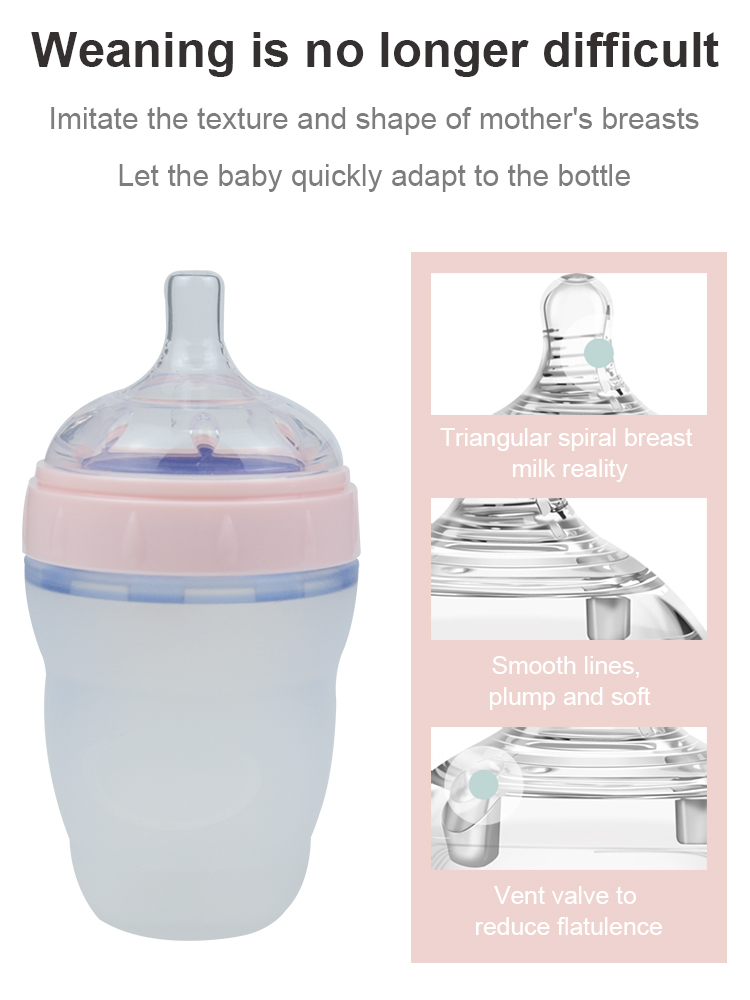source:Industry News release time:2022-07-13

If you have a baby with bottle phobia, follow the plan below to transition from breastfeeding to bottle feeding within 24 hours.
It is best to make sure your baby is older than 4 months before you start trying. If you can insist on breastfeeding, it is best to continue breastfeeding, unless it is a last resort, you can use the following ways to help your child accept bottle feeding.
1. Set aside a 24-hour period, during which time only bottle feeding. Pick a day when someone is there to help. You may need to express milk to avoid full and sore breasts, and then you can bottle-feed your baby.
2. On this day, do not give your baby anything to eat or drink for at least two to three hours before giving the bottle, until the child feels hungry and has an appetite.
3. Try different bottles and pacifiers. Soft nipples are best. Use a regular, slim bottle that will fit any size nipple.
4. If you can, it's best to use expressed milk at first, because your baby is used to the taste. If breast milk is deficient, other formulas can be used.
5. Poke a larger hole in the nipple with a sterilized needle to ensure that the flow is greater than the flow of breast milk.
This works well for a baby who cries as soon as the pacifier is in her mouth, because it gives her the feeling that the milk is flowing very smoothly.
6. The milk in the bottle should be completely warmed. Many breastfed babies prefer the milk in the bottle to be a little warmer than usual, as long as the baby can't be scalded.
7. Sit the baby upright on your lap to avoid suffocation or panic if the flow rate is too high. Don't lay your baby in your arms as you would when you're breastfeeding, this position is uncomfortable for your baby when you're bottle feeding.
8. Divert your baby's attention with toys or TVs that make sounds around you. Before your baby realizes the pacifier is in his mouth, he starts sucking unknowingly.
9. Be patient. If your baby shows signs of choking, straighten him right away, but keep the pacifier in his mouth.
10. Persevere. So far, we have found that 24 hours is the longest time a baby can last, and most babies quickly and naturally give up on breastfeeding.
Plastic milk bottles contain more BPA and should not be heated and sterilized in a steamer
The news that BPA-containing plastic feeding bottles are harmful to health makes baby parents panic: After the Canadian government banned the sale of BPA-containing baby feeding bottles, a local council in the United States recently voted to ban BPA-containing baby feeding bottles and cups with straws. Followed by the actions of some companies: 6 companies in the United States have stated that they will no longer produce baby bottles containing bisphenol A, and the baby bottles produced by these companies account for more than half of the market share in the United States; Wal-Mart in the United States has also announced that it will no longer produce BPA-containing baby bottles. The sale of BPA-free feeding bottles began earlier this year.
The reporter visited the baby product counters of many shopping malls and supermarkets in Beijing and found that the baby bottles of various brands did not clearly identify whether there was BPA, but the sales staff said: most baby bottles contain BPA.
Read recommendations:
popular recommendation
Pyramid Stacks
2022-09-17Rabbit teether
2022-01-08Hand shape teether
2022-01-08Silicone storage water bottle
2022-04-23Geometric Puzzle
2022-09-17Plush toy pacifier
2022-01-08Lollipop baby teether
2022-01-08Silicone watch blets
2022-05-27Round pacifier
2022-03-31Silicone flower teether
2022-01-12baby pacifier clip Factory
2023-04-11Nano silver day and night pacifier
2023-04-11baby pacifier mask wholesale
2023-04-11bibs baby pacifier Processor
2023-04-11pacifier chain gold custom
2023-04-11good baby pacifier Processing
2023-04-11baby medicine feeder nipple manufacture
2023-04-11bibs baby pacifier wholesaler
2023-04-11newborn baby nipple Manufacturing
2023-04-11bibs pacifier direct sales
2023-04-11How to use milk bottle cleaner
2022-03-03Pay attention to the hazards, silicone products remind you to choose kitchen utensils carefully!
2022-06-25What are the ways to treat dark marks on the surface of silicone products?teether toys silicone pric
2022-07-09Classification of bottle brushes
2022-03-04what brand of baby bottle is good.baby bottle maker Processing
2022-06-23How to identify BPA bottles?baby pacifier clips company
2022-06-25What are the different uses of silicone face wash brushes.teethers silicone manufacturer
2022-07-09Glass bottle or plastic bottle
2022-02-25comotomo is such a pacifier material.shower brush for back Production
2022-06-17Is it okay for the child to always have a pacifier?
2022-03-30